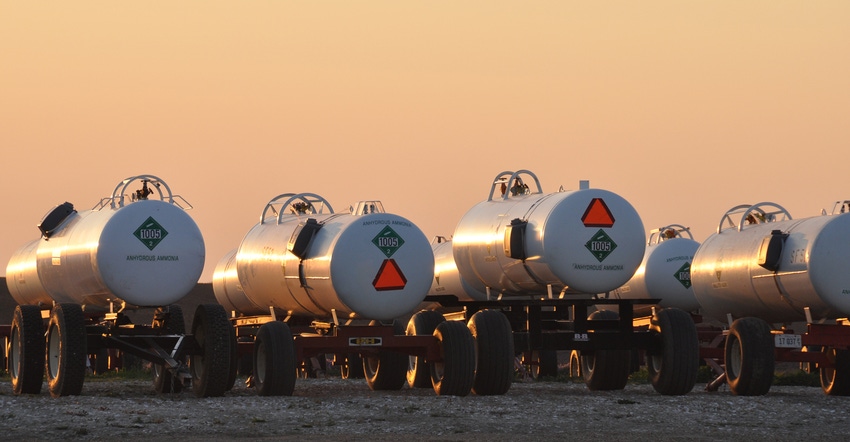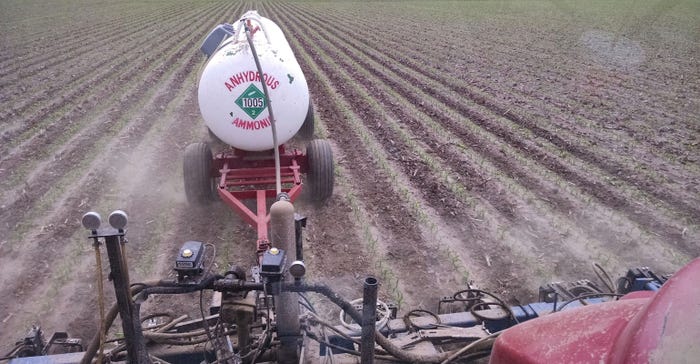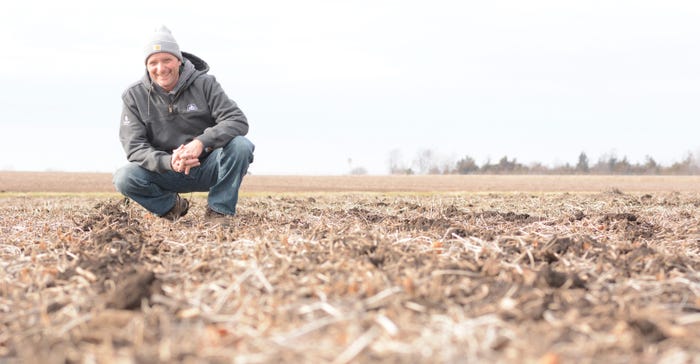
You know the scenario heading into 2022: high nitrogen prices, global supply chain hiccups and the potential for fertilizer shortages.
Farmers responded, putting on more anhydrous ammonia this fall than in years prior in an effort to avoid spring problems, says Fred Below, University of Illinois crop scientist.
Fall anhydrous ammonia application guarantees farmers have possession of nitrogen to use, but the practice isn’t problem-free, Below says. With seven months to go from application to planting, there’s a lot of time for weather and other environmental factors to reduce the amount of nitrogen in the soil.
“The reality is, fall applied can be a little less efficient than spring applied,” says Scott Foxhoven, U of I graduate research assistant. “I think the factor that scares everybody the most is availability. So, farmers are willing to spend a little bit more on a lower-efficiency practice to guarantee that they have nitrogen in the ground come springtime.”
Thinking about spring
But what exactly is the situation for 2022, and does that mean you need to reevaluate your spring nitrogen application plan?
“There are a lot of supply chain issues around the globe for everything. Unfortunately, our fertilizers have not been immune to that,” says Jay Matthews, Growmark technical agronomist. “Getting product in place and transported to the right place on time is going to be a challenge, like everything else.”
The status of product availability remains unknown until suppliers take inventory and see what farmers decide to buy for spring 2022, he adds. And some products are just easier to move than others.

What about price?
Farmers saw anhydrous prices spike in December, hitting $1,445 a ton on average across the state, and urea came in at $907.47 a ton.
While prices are not yet guaranteed for the spring, nitrogen prices could be higher than prepaid products last fall, Matthews says. “We’re hearing there is going to be a pretty large gap between ammonia and the other nitrogen products like UAN. Typically, they run at about a 10- to 12-cent-per-unit premium. We’re hearing that might be a little bit larger going into spring.”
Pricing will become clearer when cooperatives release final price lists after the first of the year, he says.
Developing a plan
Long story short: If you still have some nitrogen application to do in the spring, think ahead.
Keep an eye out for a pricing guide for penciling out your budget. And communicate with your supplier to secure inventory, Matthews says. Make sure you develop a solid plan consisting of your needs, desired total N rate and how you will split up your applications.
“One of the biggest things is to figure out what co-ops will actually be able to supply you with,” Foxhoven says. “Don’t assume, like every other year, everything’s going to be there for you.”
But be flexible. “If we can’t get some UAN for sidedress, then be open to the possibility of having to switch to urea or ammonia,” Matthews says. “Have that flexibility thought process in the back of your head.”
Comparing the options
Need a refresher on the possible nitrogen applications for spring? Foxhoven and Matthews compare the nitrogen forms:
Anhydrous ammonia. At 82% N, anhydrous ammonia is the first product formed when nitrogen is created from the air. So, it is always the cheapest form of N available, and it’s very concentrated, resulting in lower amounts of applied and effective product. But anhydrous ammonia is harder to handle, as it is hauled and stored as a pressurized liquid. That makes it more dangerous to handle, with chances for inhalation and burns.
UAN. Urea ammonium nitrate, or UAN, ranges from 28% to 32% N, which means you will need more of the product to reach your targeted total pounds of N. This also means the product is the most expensive option when everything is said and done. The product is a liquid and can be stored and hauled easily with regular equipment such as tankers.
Urea. Like UAN, urea is lower in percent N. The product is 46% N, indicating you will need more of the product and thus, need more set aside in your budget. But since urea is a dry product, it is easy to handle, store and transport. With both urea and UAN, know that ammonia volatilization can occur — the process of ammonium in urea converting to ammonia gas and being lost in the air. This happens when urea stays on residue or soil surfaces, and obviously reduces urea efficiency. Use a stabilizer to prevent this process from occurring.
And in a year when nitrogen is like gold — both rare and valuable — Matthews says to make the most of it with a stabilizer, no matter the source. Get stabilizers into your current plan, and watch them be a useful piece of the puzzle to improve yield results.
Make strategic nitrogen moves
When Ashton, Ill., farmer Allyn Buhrow changed his crop rotation plan from corn on corn to a 50-50 rotation of corn and soybeans several years ago, he also altered his nitrogen application strategy. But none of it was because of price and availability scares.
“From 2000 to 2018, we were planting more corn on corn, so we would manage nitrogen a little bit differently for corn on corn than first-year corn,” Buhrow says. “Most of our nitrogen goes on as ammonia, which works well with our heavy soil.
“The ammonia tends to last longer in our heavy, wet soil than liquid nitrogen or urea would.”
Buhrow applies 32% liquid nitrogen with his herbicide program and sidedresses anhydrous ammonia in late May when the crop emerges. Sidedressing is a practice Buhrow appreciates for the availability of nitrogen right when it matters. When you sidedress, you guarantee the nitrogen is going to be in the soil during the growing season.

This fall, Buhrow’s nitrogen application looked a bit different than previous years. But it was because of Mother Nature, not supply chain and market issues.
“A lot of times we don’t have the weather window in the fall to apply ammonia,” Buhrow says. “So, I generally don’t plan on it [fall application], but this year we got harvest and tillage done, and the weather improved in November, so we took that opportunity to do some fall ammonia on fields we would typically do in the spring.”
Sure, applying fall ammonia was probably a good idea from a pricing standpoint, he says. But it wasn’t the primary motive.
And as far as nitrogen availability, Buhrow is optimistic.
“Sometimes in the spring, inventory can get pretty tight because the application window is so narrow, but we’re in the minority as far as the way that we apply our nitrogen and when we apply it with ammonia,” he says. He’s hopeful he won’t face supply issues when he goes to apply nitrogen during crop emergence based on the amount of acres he applied with fall ammonia.
But in the end, Buhrow has found the best nitrogen strategy for him and his situation.
“We’ve tried different strategies with liquid before, but I just don’t find them to be all that effective for us,” he says. “So, I’m just an ammonia anhydrous guy because it’s usually the cheapest form to apply, and we have our own toolbar to do applications.”
About the Author(s)
You May Also Like






